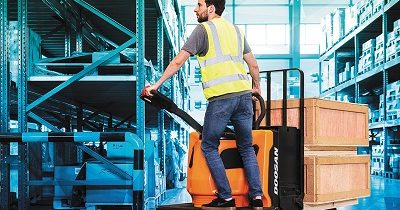Forklift Operator Training Remains Key Focus for Safety
Article from MHI Solutions Magazine
When the Industrial Truck Association (ITA) launched the first national forklift safety day seven years ago to raise awareness of the importance of forklift operator training programs, the media coverage reached 20 million people, based on the circulation or audience numbers of the press outlets running articles or airing coverage. In 2020, those numbers topped 90 million.
“Although we highlight the need for operator training and safety practices on one day each year, forklift safety is a year-round effort,” said Brian Feehan, president of ITA. Operator training remains the focus of the association’s efforts because even with enhanced safety features on equipment, it is up to the operator to operate the forklift safely, he said. “We know training works because operator incidents and injuries decreased significantly after OSHA introduced operator training requirements in 1998.”
“Training is always important, as is ongoing reinforcement of best practices to ensure safe and productive use of the lift truck,” said Perry Ardito, general manager of MHI member Jungheinrich® Warehouse Products & Automation Group at Mitsubishi Caterpillar Forklift America. “As safety best practices are continuing to evolve, we are seeing more safety managers having influence on decisions pertaining to forklift purchases and suppliers.”
It is also critical to create an overall safety culture throughout the company so everyone understands that training is about safety, not just knowing how to operate a lift truck, said Jack Kaumo, director, iWAREHOUSE Technology Solutions for MHI member The Raymond Corporation. “At a recent onsite visit, I saw 13 order pickers in one aisle, which indicated a need for a process change that will reduce the number of people in one aisle at a time.” Even if all of the order pickers operated their lift trucks properly, the congestion in the aisle increased the risk of an incident, he explained. “Warehouse operators need to evaluate all processes to determine the best practices that include training and operations processes to create a culture of safety.”
Making sure operators understand what equipment they are qualified to operate is one way to increasing awareness of lift truck operator safety, said David Nicolette, technical trainer at MHI member CLARK Material Handling Company. “Operators are required to be re-evaluated once every three years, but some employers also provide each operator a permit that identifies what equipment they have been trained to operate and where they can operate,” he said. There is no set format for employer-issued permits but they may include information such as the operator’s name, dates of training, specific equipment and areas of the facility in which they can operate the specific equipment. “Some operators are permitted to operate only on the loading dock while others might be trained for work in production areas, and the operator’s permit should clearly outline these restrictions.”
Refresher training requirements
In addition to an operator’s initial training on a lift truck, OSHA also requires refresher training in several situations, said Nicolette. “Unfortunately, there are many employers who still view operator training only needing to occur once every three years to maintain certification, because they do not understand the requirements for refresher training. The five refresher training triggers identified by OSHA are:
1. Operator has been observed to operate the vehicle in an unsafe manner
2. Operator has been involved in an accident or near-miss incident
3. Operator has received an evaluation that reveals that the operator is not operating the truck safely
4. Operator is assigned to drive a different type of truck
5. A condition in the workplace changes in a way that could affect safe operations of the truck
Continue reading full article in MHI Solutions
CREDIT: DOOSAN INDUSTRIAL VEHICLE AMERICA CORP.





